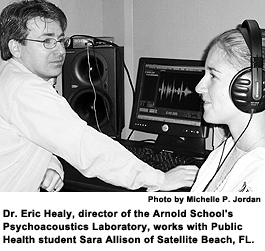


|
|
|
|
|
|
|
|
|
|
|
|
||||||||||||||
|
||||||||||||||
|
|
||||||||||||||
|
||||||||||||||
|
Posted
11/15/2006
In this case, the bionics are cochlear implants, devices which allow deaf or hard-of-hearing patients to acquire, or regain, functional hearing. Unlike the show’s character, though, implant recipients don’t have to spend millions. “Cochlear implants are the most successful neural prosthetics in history,” said Dr. Eric Healy, an assistant professor in the Arnold School of Public Health’s Department of Communication Sciences and Disorders. USC's Speech and Hearing Center has been providing services to cochlear implant recipients of all ages, from infants to the elderly, since 1998. Cochlear implants, which received FDA approval in 1984, are electronic appliances that are implanted in the skull behind the ear. They provide recipients with functional representations of sounds – representations that help that person to understand and develop speech and to hear environmental sounds. While cochlear implants are functionally amazing, they do not restore or replace normal hearing. For example, the subtle cues that lend as much meaning to spoken language as the words themselves – signals such as syllable stress, pitch and inflection – can be lost to those who hear via cochlear implants. The result is that a person may be unable to distinguish a question from a statement, discriminate a loved one’s voice from a stranger’s voice, or determine word meaning based on stress (for example: present, n., versus present, v.). While cochlear implant hearing is not yet perfect, it can be improved, thanks to researchers like Healy and Dr. Cheryl Rogers, a clinical instructor at USC’s Speech and Hearing Center. With funding from the National Institutes of Health, Healy and Rogers, along with a research team, have been studying how cochlear implant users process simultaneous cues – signals such as pitch and loudness that occur at the same time, as they do in real life – and have gotten some startling, yet positive, results. It seems that although cochlear implants fall short in several other ways in comparison to normal hearing, the implant’s ability to process simultaneous cues is absolutely perfect. In this regard, the cochlear implant is as good as normal hearing. These results are so startling because previous studies have shown significant weakness in the device’s ability to process an individual cue presented only one at a time. If the implant exhibits deficits in processing only one aspect of a signal, it’s easy to assume the addition of other cues would be even more troublesome – but Healy and his team have found that is not the case. “It’s a real breakthrough because it can help engineers build devices that would improve the perception of individual cues,” said Healy, who also is the director of the Arnold School’s Speech Psychoacoustics Laboratory within the Arnold School of Public Health. Improving the perception of individual cues is key to enhancing a listener’s overall sensitivity to complex sound. And speech, like practically every sound in nature, is a complex, multilayered sound. It’s like wearing a pair of glasses in which the prescription of each lens is just a bit off. On the whole, you can see well enough to drive a car, read or watch television. But if each individual lens were adjusted to the perfect prescription, your overall vision would be so much clearer –like switching from standard to high-definition television. That’s a fairly apt analogy for the importance of improving perception of individual cues for cochlear implant recipients. Healy has shown that if the individual signals are tweaked, then the overall sensitivity to sound is improved as well. People will be more likely to hear the nuances of language, the small changes in pitch, stress and loudness that imbue our utterances with meaning. “Our ability as listeners to reassemble cues is like putting together pieces of the auditory puzzle, and people with cochlear implants do that very well. So now we can concentrate on making each piece better. Any increase in sensitivity in one cue will increase the sensitivity to multiple cues,” he said. “Cochlear implants are still not perfect, but we’re working on it.” For more information about USC's cochlear implant program: |
| Columbia, SC 29208 • 803-777-7000 • sphweb@gwm.sc.edu | © University of South Carolina Board of Trustees |
 Bionics is no longer merely the stuff of science fiction. Like the
fictional Six Million Dollar Man of 1970s television, real people today
are using bionic devices to replace non-working body parts.
Bionics is no longer merely the stuff of science fiction. Like the
fictional Six Million Dollar Man of 1970s television, real people today
are using bionic devices to replace non-working body parts.